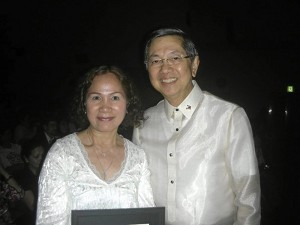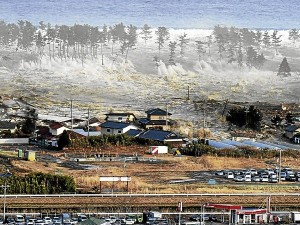Miyagi’s quiet hero

Ambassador Manuel M. Lopez handed Marlene de Quina Shoji of Cotabato City a certificate of recognition for her service to the Filipino community during the great East Asian quake and tsunami early this year (inset). Marlene insisted the award be given to Miyagi International Association and not to her personally.
SENDAI CITY, Miyagi Prefecture—A woman from Cotabato City, who can speak Japanese, English, Filipino and a Spanish patois (Chavacano), suddenly found herself coordinating efforts here to help Filipinos and other foreigners in the wake of the earthquake, tsunami and nuclear disaster early this year.
Marlene de Quiña Shoji, who has since been recognized for her heroic efforts and who coordinated President Aquino’s visit to a northern Japan disaster area, was herself a victim of the disaster. The tsunami swept away her house in Gamo, Miyagino-ku near the airport.
Had she not visited a friend from the Philippines in the city center, about an hour’s drive from her home, she might have been among some 150 people killed in her neighborhood, Marlene said.
Luckily, no one in her family died during the tsunami. Her husband was then working at a linen factory. Their son, Norihiko “Moses Ian,” 35, and daughter-in-law, Minako, also survived. Minako, however, suffered a miscarriage.
Marlene said it was only on March 14, three days after the magnitude-9 quake and tsunami struck, that she was able to go to the place where their house once stood. She found only the foundation.
Family pictures gone
Gone were her most cherished possessions like pictures of her son when he was a baby, and of her parents and parents-in-law. The videos of her parents were also lost.
“I lost most of the important things,” Marlene, who came to Japan in 1975 and got married the following year, told a group of journalists from Asia invited by the Ministry of Foreign Affairs last month to look at recovery efforts in the country.
Sto. Niño
She particularly missed her altar that included a two-foot Sto. Niño statue, a cross, and pictures of Jesus and Mama Mary.
Gone, too, was a Japanese altar with tablets in memory of her in laws.
This sense of loss took a backseat as her cell phone was swamped with calls.
The calls came from Filipinos in Miyagi Prefecture, where this city is located, and from the Philippine Embassy and the Philippine media.
Most callers were seeking information about family members, relatives, acquaintances and friends, and about possible radiation from the nuclear reactors in Fukushima Daiichi.
Advise hotline
She also received calls from Filipinos seeking advice whether to go back to the Philippines or stay in Japan.
There are some 1,000 Filipinos in Miyagi, 380 of whom are in Sendai. They are mostly women married to Japanese, according to Marlene.
Some are exchange students of Tohoku University (15 at the time), who all returned to the Philippines shortly after the disaster. “They came back in April,” Marlene told the Inquirer on Oct. 25 at the office of the Miyagi International Association.
Other callers raised concerns about their passport, work and medical needs. A number of Filipinos lost their jobs in the prefecture because some hotels were damaged and closed.
Relatives and friends, worried about the radiation, urged Marlene to return to the Philippines. “I got calls from my sister, brother, nephew and niece,” she said.
But she decided to remain in Japan. She had a husband and son to think about, she said, adding “I also didn’t want to cause anxiety among Filipinos who depended on me.”
Calls from widows
She would later receive calls from wives who lost their husbands in the tsunami and from people who stayed in evacuation centers for some time because their homes had been washed away.
“In addition to relaying information provided by the government and various support organizations, I tried my best to provide the disaster victims with comfort and encouragement,” she said.
4 Filipino fatalities

“One of those who died arrived in Japan just three days before the disaster. She returned from a trip to the Philippines where she left her pre-teen daughter,” Marlene said.
The earthquake and tsunami killed 15,26 people and injured 5,617, mostly in the Fukushima, Iwaki and Iwate prefectures. A total of 4,953 are missing, according to the Japanese Red Cross.
Marlene recalled the chaos shortly after the quake. It was frightening, she said. “I had no contact with my husband.”
Canned food, ramen
Food was a problem on the first day. “We cannot buy food,” she said. “Canned food and ramen were our main sources of sustenance.”
She and another Filipino married to a Japanese roamed the city looking for food.
Marlene lacked food but she had a cell phone, which became a lifeline to many.
Thais, Chinese, too
Foreign nationals like Thais, Chinese and Americans also contacted her.
“Even Spanish-speaking people called me up because I speak Chavacano (a Spanish patois mainly spoken in Zamboanga City in Mindanao),” said Marlene, a former assistant in a clinic of a certain Dr. Balolong in Cotabato City.
She said many people turned to her because she had been in Japan for 36 years.
International association
She happens to be a counselor of the support center for foreign nationals of the Miyagi International Association. MIA facilitates the participation of the prefecture’s citizens in international exchange.
It was Marlene who organized the sending of relief items like food and clothing to areas these were needed. The goods came from such groups as the Hawak Kamay, the International Catholic Church in Tokyo and the embassy.
She also coordinated the visit of doctors from the Philippines and 50 people from El Shaddai, who conducted a fellowship and gave out rice.
A month after the disaster, she founded Philcom Miyagi, an association of Filipinos in the prefecture, at a Catholic church here where she initiated the holding of English Mass 28 years ago.
The group counts more than 500 members, including 200 in Sendai.
“We cooked adobo and sold items at a church bazaar on Oct. 23. We earned ¥22,000,” she said.
Marlene said Filipinos in the area usually get together at the Mototera cathedral every third Sunday for the Mass in English. The Mass is conducted by a Canadian priest.
Recognition
For its work following the disaster, the Miyagi International Association received a certificate of appreciation from Philippine Ambassador Manuel M. Lopez during the Philippine Independence Day ceremony in Tokyo.
It reads, “In grateful recognition of her generous support and dedicated service to the Filipino communities from the Tohoku Region in the aftermath of the Great East Asian Earthquake of March 11,2011.”
It was really meant for Marlene but she insisted that it be given to the group, according to her Japanese colleague at the association office here.
With P-Noy
Months later, she would coordinate with the Philippine consul general for President Aquino’s three-hour visit to Ishinomaki, one of the devastated cities northeast of Sendai, on Sept. 26.
“I was with the President in Ishinomaki and I delivered a speech before a crowd of Filipinos,” she said. The group included factory workers and housewives, a number of whom came from Sendai, Fukushima and Kesennuma.
Mr. Aquino donated $1 million to Ishinomaki for its reconstruction efforts.
Subsidized housing
Marlene and her husband now stay in an apartment downtown, paid for by the city government.
They moved in May into a unit with a kitchen, a living room and two bedrooms. The rent is ¥86,000 a month, within the subsidy of up to ¥88,000. But they can stay there for only two years.
Before she moved into the government-paid housing, she stayed in the home of a friend from the Philippines, and later in a small apartment she rented.
Marlene said she did not go to an evacuation center because of her allergy to dust.
By the numbers 220,000 number of Filipinos in Japan in 2010, including 2,226 in Fukushima, 1,407 in Miyagi and 910 in Iwate. Filipinos are the fourth largest group after the Chinese, Koreans and Brazilians.
80
percentage of Filipinos who are permanent residents of whom 90 percent have Japanese spouses.
4,000
number of factory workers, trainees and professionals (engineers, nurses, managers)
2,000
number of engineers
800
number of exchange students
76
number of professors
2
number of foreign nurses who passed the Japanese board exam
Ambassador Manuel M. Lopez handed Marlene de Quina Shoji of Cotabato City a certificate of recognition for her service to the Filipino community during the great East Asian quake and tsunami early this year (inset). Marlene insisted the award be given to Miyagi International Association and not to her personally.